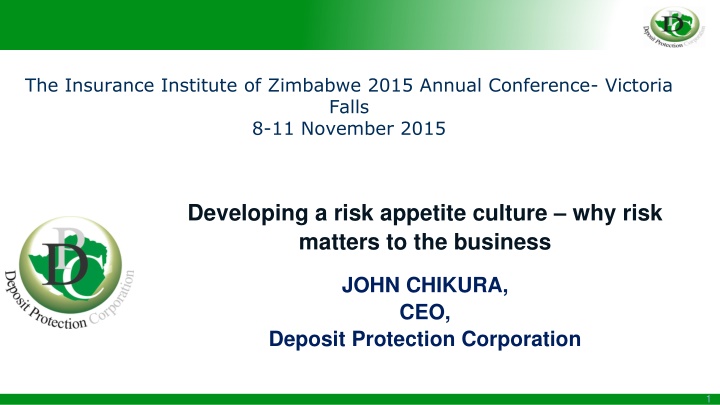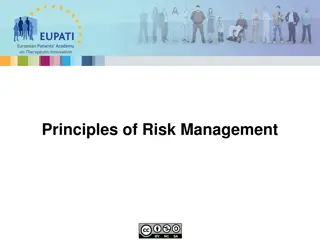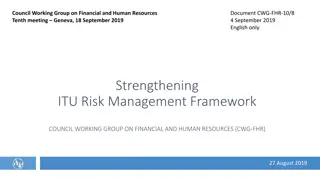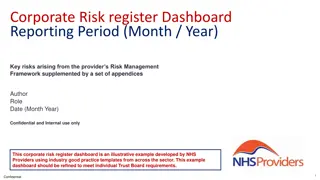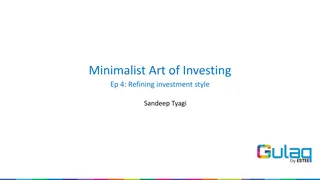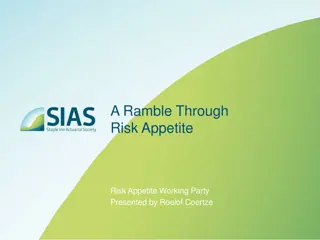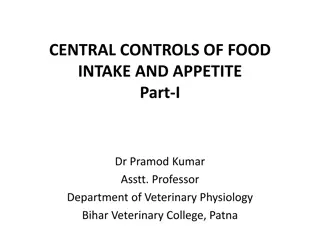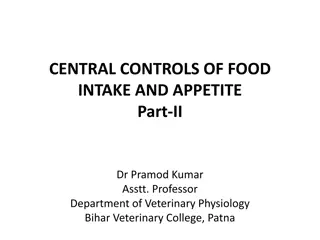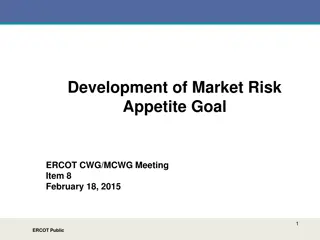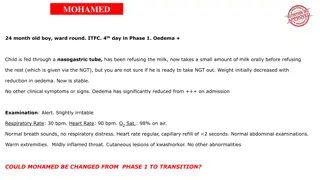Developing a Risk Appetite Culture: Importance and Framework
Risk management plays a critical role in the success of corporations, with strategy and risk being intertwined. This presentation delves into definitions of key terms such as risk appetite, the Risk Appetite Cycle, characteristics of a well-defined risk appetite, and the importance of expressing risk appetite within an organization. It emphasizes the significance of developing a risk culture, implementing a risk appetite framework, and aligning risk appetite with overall management strategies.
Download Presentation

Please find below an Image/Link to download the presentation.
The content on the website is provided AS IS for your information and personal use only. It may not be sold, licensed, or shared on other websites without obtaining consent from the author.If you encounter any issues during the download, it is possible that the publisher has removed the file from their server.
You are allowed to download the files provided on this website for personal or commercial use, subject to the condition that they are used lawfully. All files are the property of their respective owners.
The content on the website is provided AS IS for your information and personal use only. It may not be sold, licensed, or shared on other websites without obtaining consent from the author.
E N D
Presentation Transcript
The Insurance Institute of Zimbabwe 2015 Annual Conference- Victoria Falls 8-11 November 2015 Developing a risk appetite culture why risk matters to the business JOHN CHIKURA, CEO, Deposit Protection Corporation 1
Presentation Outline Introduction & Importance of Risk Management Definitions of Key Terms Risk Appetite cycle Characteristics of a well defined Risk Appetite Importance of Expressing Risk Appetite Factors affecting Risk Appetite Risk Culture Developing a Risk Culture Risk Appetite Framework Risk Appetite and Management Developing, Communicating and Monitoring Risk Appetite Conclusion 2
INTRODUCTION Risk management is critical to the success of corporations. Strategy & risk are inseparable. Strategy is about survival, growth, & competitive advantage, however companies will fail if they do not manage risk In the main strategy is about managing risk to be able to exploit opportunities fully. So strategy & risk are the core content of directors functions/responsibilities Boards being responsible for the oversight of corporations are expected to annually report to shareholders major risks the company faces They are expected to articulate measures put in place to mitigate & manage identified risks 3
Definitions of Key Terms According to Peter Moles, risk can be defined as the chance (or probability) of a deviation from an anticipated outcome . There are several definitions of risk. Most definitions only focus on the downside of risk. Risk appetite is the amount of risk, on a broad level, that an organisation is willing to take on, in pursuit of value. Or, in other words, the total impact of risk an organisation is prepared to accept in the pursuit of its strategic objectives. (KPMG Australia,2008). An organization s risk appetite captures the organizational philosophy desired by the board for managing and taking risks. Ideally, this should help to frame and define the organization s expected risk culture and guide overall resource allocation. It may be instructive to conceptualize a Risk Appetite Cycle. 4
Risk Appetite Cycle Source: Institute of Actuaries of Australia 5
Definitions of Key Terms (Cont.) Source: Institute of Actuaries of Australia (2011) 6
Characteristics of a well defined Risk Appetite Reflective of strategy, including organizational objectives, business plans and stakeholder expectations. Reflective of all key aspects of the business. Acknowledges a willingness and capacity to take on risk. Is documented as a formal risk appetite statement. Considers the skills, resources and technology required to manage and monitor risk exposures in the context of risk appetite. Is inclusive of a tolerance for loss or negative events that can be reasonably quantified. Is periodically reviewed and reconsidered with reference to evolving industry and market conditions. Has been approved by the board. 7
Importance of Expressing Risk Appetite Research on risk appetite (Association of Insurance and Risk Managers, 2009) has identified four ways in which an understanding and expression of risk appetite can be used within organisations: a) To support strategy-setting, leading to a balanced risk profile and identification of which risks to avoid and which to take; b) To support effective management of risk, by ensuring that risk management resources are allocated optimally, and fostering a risk- aware culture across the organisation; To set appropriate boundaries for risk-taking, by motivating decision-makers to make better and more consistent decisions; and d) To maximize stakeholder value, by enhancing organisational performance and delivery. c) 8
Risk Culture In Enterprise-wide Risk Management, Risk Culture comprises of the norms and traditions of behavior of individuals and of groups within an organization that determines the way in which they identify, understand, discuss and act on the risk the organization confronts and takes (Risk & Ins. Mgt Society 2012) A successful risk culture would include: a) A distinct and consistent tone from the top from the board & senior management in respect of risk taking and avoidance; b) A commitment to ethical principles; A common acceptance through the organization of the importance of continuous management of risk; and d) Transparent and timely risk information flowing up and down the organization. c) 10
Risk Culture (Cont.) Case study In May 2012 JPMorgan Chase disclosed a multi-billion-dollar trading loss on its synthetic trading portfolio (a credit derivative portfolio). By its own admission the events that led to the company s losses included inadequate understanding by the traders of the risks they were taking; ineffective challenge of the traders judgment by risk control functions; weak risk governance and inadequate scrutiny (Dimon, 2012). According to the New York Times, individuals amassing huge trading positions were not effectively challenged, there were regular shouting matches and difficult personality issues.(New York Times, 2012 Consider the case of the banking sector in Zimbabwe in 2004 11
Why is Risk Culture Important? Does risk matter to business? All organisations need to take risks in order to achieve organisational objectives. Profit is the reward for managing risk. Need to understand risks across the business i.e. market risks, operating risks, liquidity risk, legal risk, counterpart credit risks, reputational risk etc. The prevailing risk culture within an organisation can make it significantly better or worse at managing these risks. Risk culture significantly affects the capability to take strategic risk decisions and deliver on performance promises. Organisations with inappropriate risk cultures will inadvertently find themselves allowing activities that are totally at odds with stated policies and procedures or operating completely outside these policies. An inappropriate risk culture may lead to serious reputational and financial damage. Problems with risk culture are frequently found at the root of organisational scandals and collapses e.g. the Enron case and rogue traders such as Nick Leeson (Barrings Bank-1995) 12
Four factors driving risk culture There are four factors driving risk culture up the agenda Leadership pressure Boards and senior management are increasingly having to show they hold staff at all levels of the organisation accountable for their behaviour. Boards seeking comfort that management is fostering a sound risk culture which supports the strategy and risk appetite. Regulatory pressure New international standards (e.g., King, Basil & Solvency) and domestic (e.g., Zimcode on CG, ZSE, SECZ ) guidance lays out tougher regulatory expectations to set, measure and monitor risk culture. Supervisory attention is turning from control functions to behaviours of front line staff, executive management, and boards. 13
Four factors driving risk culture Negative public sentiment Ongoing failures, fines and settlements have made public question the underlying ethics of those in financial sector. Deeply held view that financial sectors cultures put their interests ahead of customers and society s, for example, banks & insurance companies in Zimbabwe Higher consumer protection standards Considerable settlements and fines for actions that are detrimental to customers have greatly elevated conduct risk. Customerfirst approaches focus heavily on culture and ethics. Firms are moving from a pay the fine to a avoid the fine philosophy. 14
Risk Culture (Cont.) Risk culture creates the platform for effective risk management through: Creating an enabling ERM framework; Shaping corporate behaviours of board, management and staff; Dealing with dysfunctional behaviours; as well as Defining board and board committee roles & responsibilities. 15
Risk Culture Framework Source: Institute of Risk Management 16
Risk Culture Framework (Cont.) Personal predisposition to risk People vary in all sorts of ways and this includes their predisposition towards risk. Personal ethics Organisations need to pay attention to the ethical profile of those working in their business. Every individual comes with their own balance of moral values and these have great influence over the decisions they make on a day-to-day basis. Behaviours Risk behaviour comprises external observable risk-related actions, including risk-based decision-making, risk processes, risk communications etc. The Organisational Level Individual values and beliefs and attitudes towards risk contribute to and are affected by the wider overall culture of the organisation. The sociability vs. solidarity model (Goffee and Jones, 1998) (also called the DoubleS model) considers culture in relation to two key dimensions: sociability (people focus - based on how well people get on socially); and solidarity (task focus - based on goal orientation and team performance). a) b) 17
Developing a Risk Culture Monitoring risk tolerances requires a culture that is aware of risk and risk appetite. Management, by revisiting and reinforcing risk appetite, is in a position to create a culture whose organizational goals are consistent with the board s, and to hold those responsible for implementing risk management within the risk appetite parameters. Many organizations are effective at creating a risk-awareness culture: a culture that emanates from senior management, cascades through the organization, and is supported by the board. In an effective culture, each member of the organization has a clear idea of what is acceptable, whether in relation to behaving ethically, pursuing the wrong objectives, or encountering too much risk in pursuing the right objectives. 18
Developing a Risk Culture Creating a culture is one way of reinforcing overall risk appetite. The approach is best used when the organization has a well-communicated risk appetite and associated risk tolerances, to the point at which the following outcomes exist: Consistent implementation across units; Effective monitoring and communication of risk and changes in risk appetite; Consistent understanding of risk appetite and related tolerances for each organizational unit; Consistency between risk appetite, objectives, and relevant reward systems This approach draws on ongoing and separate evaluations conducted as part of the organization s monitoring. Individuals doing the monitoring consider whether the objectives being set and the risk response decisions being made are consistent with the organization s stated risk appetite (even if you make money, punish wrong-doing). Any variation from the stated (or desired) risk appetite is then reported to management and the board as part of the normal internal reporting process. a) b) c) d) 19
Risk Appetite Framework In the case of an insurer, an appropriate risk appetite framework is more concerned with the impact of rare events on the company s financial condition. With probability analysis, stress testing and correlation analysis, the distribution and range of possible outcomes may be discovered. These are very useful tools for senior management s strategic planning. Fundamental step in a risk appetite framework is the definition of an organization s willingness and ability to take risk based on the input from the board of directors and senior executives. Just as an individual investor must evaluate his or her risk appetite or risk objective when managing personal portfolios and setting reasonable return requirements, an institution needs to look at its unique situation to define its risk appetite. 21
Risk Appetite Framework (Cont.) Risk appetite is a high-level view of the risks the insurer is willing to assume in pursuit of value. When insurers define the optimal level of risk, the ultimate priority is to serve shareholders interests. Before setting up the risk appetite, it is essential to have a clear picture of the market and the company s risk capacity. This will facilitate the decision on the type and magnitude of risk to be taken consistent with business strategies and market situation. The desired risk profile shall satisfy the constraints set by other parties such as regulators, rating agencies, policyholders, debt holders, senior management and employees. Some external changes have expedited the process of setting risk appetite. S&P has required a clear statement of risk appetite as a foundation of strong or excellent ERM rating. 22
Risk Appetite Framework (Cont.) Risk appetite framework normally includes three increasingly detailed levels. 1. Enterprise risk tolerance: The aggregate amount of risk the company is willing to take. 2. Risk appetite for each risk category Enterprise risk tolerance needs to be allocated to risk appetite for specific risk categories and business activities, such as selling life insurance policies or underwriting property and casualty risks, or taking more market risk versus credit risk. 3. Risk limit Risk limits are the most granular level used for business operation. It translates enterprise risk tolerance and risk appetite for each risk category into risk-monitoring measures. The consistency between risk limit and enterprise risk tolerance helps the company realize its risk objective and maximize risk-adjusted return. 23
Risk Appetite and Management The concept of a riskappetite is key to achieving effective risk management and it is essential to consider it before moving on to consideration of how risks can be addressed. The concept may be looked at in different ways depending on whether the risk (the uncertainty) being considered is a threat or an opportunity: a) When considering threats the concept of risk appetite embraces the level of exposure which is considered tolerable and justifiable should it be realised. In this sense it is about comparing the cost (financial or otherwise) of constraining the risk with the cost of the exposure should the exposure become a reality and finding an acceptable balance; b) When considering opportunities the concept embraces consideration of how much one is prepared to actively put at risk in order to obtain the benefits of the opportunity. In this sense it is about comparing the value (financial or otherwise) of potential benefits with the losses which might be incurred (some losses may be incurred with or without realising the benefits). Risk appetite is best expressed as a series of boundaries, appropriately authorised by management, which give each level of the organization clear guidance on the limits of risk which they can take, whether their consideration is of a threat and the cost of control, or of an opportunity and the costs of trying to exploit it. An organisation s risk appetite is not necessarily static; in particular the Board will have freedom to vary the amount of risk which it is prepared to take depending on the circumstances at the time. 24
Risk Appetite and Management (Cont.) The concept of risk appetite can be further analysed thus: 1. Corporate Risk Appetite: Corporate risk appetite is the overall amount of risk judged appropriate for an organisation to tolerate, agreed at board level. This may not be just one statement: for example, look at 5 key risk areas (policy/guidance risk; people and internal systems risk; propriety, regularity, finance and accountability risk; reputation risk; external risk) and make a statement on risk appetite for each. 2. The Board and senior managers should judge the tolerable range of exposure for the organisation and identify general boundaries for unacceptable risk (or at least for risks that should always be referred to/escalated up to the Board for discussion and decision when they arise); 3. Delegated Risk Appetite: The agreed corporate risk appetite can then be used as a starting point for cascading levels of tolerance down the organisation, agreeing risk appetite in different levels. The effect of this is that what is considered a high level of risk at one level will be a lower level of risk to a higher level of management.), and empowers people to innovate within their delegations; 4. The level of risk appetite will obviously vary, with a speculative project taking on higher levels of risk than a normal operation. 25
Developing, Communicating and Monitoring Risk Appetite To determine risk appetite, management, with board review and concurrence, should take three steps: 1. Develop risk appetite; 2. Communicate risk appetite; and 3. Monitor and update risk appetite 26
Developing, Communicating and Monitoring Risk Appetite Develop Risk Appetite Developing risk appetite does not mean the organization shuns risk as part of its strategic initiatives. Just as organizations set different objectives, they will develop different risk appetites. There is no standard or universal risk appetite statement that applies to all organizations, nor is there a right risk appetite. Management and the board must make choices in setting risk appetite, understanding the trade-offs involved in having higher or lower risk appetites. Communicate Risk Appetite Several common approaches are used to communicate risk appetite. The first is to create an overall risk appetite statement that is broad enough yet descriptive enough for organizational units to manage their risks consistently within it. The second is to communicate risk appetite for each major class of organizational objectives. The third is to communicate risk appetite for different categories of risk. 27
Developing, Communicating and Monitoring Risk Appetite Monitor and Update Risk Appetite Once risk appetite is communicated, management, with board support, needs to revisit and reinforce it. Risk appetite cannot be set once and then left alone. It should be reviewed in relation to how the organization operates, especially if the entity s business model changes. Management should monitor activities for consistency with risk appetite through a combination of ongoing monitoring and separate evaluations. Internal auditing can support management in the monitoring. In monitoring risk appetite, organisations should focus on creating a culture that is risk-aware and that has organizational goals consistent with the board s. 28
Inter-relationship of Strategy, Management Decisions and Risk Appetite 29
Conclusion John Harvie (Director, Protiviti Insurance and Business) quoted by the Institute of Risk Management says Culture is an environment, a petri dish in which certain behaviours and characteristics are allowed to flourish or not. Determining risk appetite is an element of good governance that managements and boards owe to stakeholders. Risk appetite should be descriptive enough to guide actions across the organization. Management and the board should determine whether compensation incentives are aligned with risk appetite, not only for top management but throughout the organization. The board should set, communicate and enforce a risk culture that consistently influences, directs and aligns with the strategy and objectives of the business and thereby supports the embedding of its risk management frameworks and processes. Risk Appetite is a fundamental component of an ERM Framework If companies are to flourish developing & maintaining a conducive risk appetite culture is critical 30
Q & A 31
